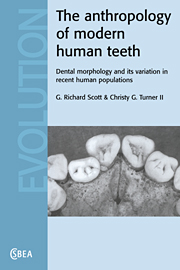 The Anthropology of Modern Human Teeth
The Anthropology of Modern Human Teeth Book contents
- Frontmatter
- Dedication
- Contents
- Acknowledgments
- Prologue
- 1 Dental anthropology and morphology
- 2 Description and classification of permanent crown and root traits
- 3 Biological considerations: ontogeny, asymmetry, sex dimorphism, and intertrait association
- 4 Genetics of morphological trait expression
- 5 Geographic variation in tooth crown and root morphology
- 6 Establishing method and theory for using tooth morphology in reconstructions of late Pleistocene and Holocene human population history
- 7 Tooth morphology and population history
- Epilogue
- Appendixes
- References
- Index
3 - Biological considerations: ontogeny, asymmetry, sex dimorphism, and intertrait association
Published online by Cambridge University Press: 05 September 2015
- Frontmatter
- Dedication
- Contents
- Acknowledgments
- Prologue
- 1 Dental anthropology and morphology
- 2 Description and classification of permanent crown and root traits
- 3 Biological considerations: ontogeny, asymmetry, sex dimorphism, and intertrait association
- 4 Genetics of morphological trait expression
- 5 Geographic variation in tooth crown and root morphology
- 6 Establishing method and theory for using tooth morphology in reconstructions of late Pleistocene and Holocene human population history
- 7 Tooth morphology and population history
- Epilogue
- Appendixes
- References
- Index
Summary
Introduction
In chapter 2, we focused on directly observable phenotypes of the tooth crowns and roots. In the next chapter, we discuss how studies of twins, families, and populations have shed light on the genetics of morphological trait expression. This intervening chapter on dental development and related topics is appropriately placed, given Butler's (1982:45) statement that the ‘link between gene and character is ontogeny.’ While it is beyond the scope of this work to review all the intricacies of dental ontogeny, we discuss in general terms how odontogenesis generates crowns and roots, major and minor cusps, ridges, fissure patterns, extra roots, and so forth. We also address organizing principles proposed to account for patterned morphogenetic gradients in the mammalian dentition with special reference to human crown and root traits.
Sections: ‘Fluctuating asymmetry’, ‘Sex dimorphism’, and ‘Intertrait association’ deal with three additional biological concerns of dental morphologists. Teeth in the two sides of the upper and lower jaws are bilateral structures that show mirror imaging (this is why isolated teeth can be determined as right or left antimeres). If the images were mirrored in all details, there would be perfect symmetry. Few anatomical structures expressed bilaterally (e.g., right and left hands; right and left ears) show complete symmetry; teeth are no exception. The asymmetry sometimes observed in crown and root trait expression has both developmental and methodological implications. Humans exhibit some degree of sexual dimorphism in all measurable body parts, including tooth size. But, do morphological traits show similar male-female differences or are they primarily monomorphic in frequency and expression? In the last section, we review interrelationships within and between crown traits, tooth size, and agenesis.
Although labeled ‘biological considerations’, this chapter is also concerned with methodology. The dental system, with repeated and bilateral structures, allows considerable leeway in how workers score dental traits and derive population frequencies for genetic and anthropological studies. At the beginning of any study, workers have to determine how to deal with asymmetry, sex differences, and trait independence. We review the different approaches that can and have been followed by various workers and discuss our approach to dental morphological analysis. Our explicit theoretical position is that most variation in asymmetry, sex dimorphism, and other minor differences within individuals results from environmental factors.
- Type
- Chapter
- Information
- The Anthropology of Modern Human TeethDental Morphology and its Variation in Recent Human Populations, pp. 74 - 130Publisher: Cambridge University PressPrint publication year: 1997
- 1
- Cited by


